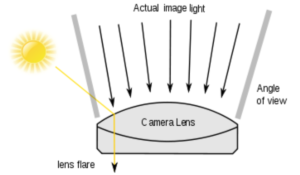Lens Flare in Photography: A Complete Guide

The introduction:
It is often said that lens flares, those mesmerizing bursts of light that dance across photographs, evoke a sense of magic and wonder. However, they can sometimes be viewed as unwelcome intruders that mar otherwise perfect shots. This comprehensive guide explores lens flare in photography, exploring its nature, causes, types, and control techniques.
Lens flare explained:

Spots or streaks of light are caused by stray light entering the lens and reflecting off the interior elements. Artifacts can appear as unwanted surprises in photographs, but when used deliberately, they can add visual interest and enchantment.
Lens flare is caused by the following factors:
The sun or artificial light sources can cause lens flare, as well as subjects that block bright light sources. By allowing more light into the lens system, zoom lenses and lens filters can increase the risk of lens flare.
Lens flares can be classified as follows:
Different lens flares have different characteristics and causes. Lens flare manifests itself in many ways, including starbursts, ghosting, veiling, sensors flares, and anamorphic flares.
Lens flare can be avoided by following these steps:

Lens flare can be minimized or avoided using several techniques. Lens hoods, blocking light with your hand, removing lens filters, recomposing your shot, adjusting shooting times, using wider apertures, and post-processing techniques can all reduce unwanted flare.
Post-processing Lens Flare:
It is possible to remove lens flare during post-processing using software tools such as Adobe Lightroom and Photoshop. You can eliminate flare artifacts with healing brushes, clone stamps, and content-aware fill tools, but you may need to experiment to find the most effective solution.
Digitally adding lens flares:

Software like Adobe Photoshop provides tools to simulate flare effects for photographers who wish to add lens flares digitally. The intensity and positioning of lens flares in an image can be controlled by duplicating the layer and applying flare filters or rendering options.
In conclusion:
In photography, lens flares have evolved from imperfections to intentional elements that add depth, drama, and visual interest to images. The techniques outlined in this guide will help photographers capture the enchanting beauty of lens flares and elevate their creative expression. Understanding the nature and manipulation of lens flares opens up a world of possibilities for artistic exploration and storytelling, regardless of whether you capture them in-camera or add them digitally.



